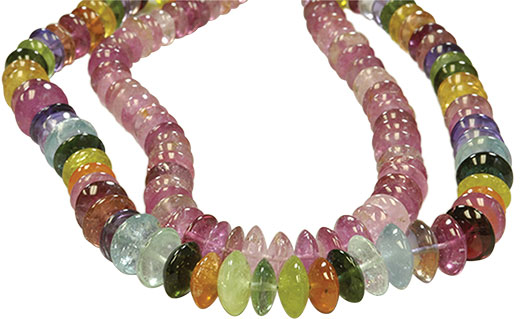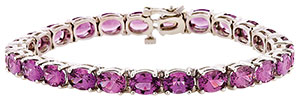|
Colored Gemstone
The Tucson Color Wheel
Buyers headed to the AGTA GemFair and other gem shows in Tucson with a list of stones to purchase and an eye out for an extraordinary rock.
By Sheryl Jones
 |
| Tourmaline beads. Photo courtesy James Alger. |
“The AGTA gem show is the only time buyers know they will see gemstones they will not see at any other show,” said Douglas Hucker, CEO of the American Gem Trade Association (AGTA) “And they know that if they don’t buy those stones right then, they will be gone.” Knowing there is a possibility of missing out on that one fabulous gemstone that could make the difference in turning a good year into a great one is the reason Hucker said that this year, “people showed up early to buy.”
The annual pilgrimage to Tucson, Arizona, for the gemstone shows took place the first week of February. It is known in the industry as one of the few times buyers can shop as many as 20 different gem shows that are happening simultaneously in and around Tucson. It is an opportunity to discover unusual, one-of-a-kind gemstones that can make the difference in a designer’s collection or set one retailer apart from all the others.
James Alger, James Alger Inc., New York, who has exhibited in Tucson for 38 years at the AGTA and Pueblo Gem and Mineral shows, noted that in previous years he sold about 20 percent of his inventory at the Pueblo gem show before the start of the AGTA show. But this year, he said, “I sold much more before the start of the AGTA show, about two-and-a-half times as much as 2016 since people were eager to buy.”
 |
| Raspberry rhodolite garnet. Photo courtesy Akiva Gil. |
Buyers may have been ready to fill holes in their inventory or to buy unique gemstones but several exhibitors noted that attendance seemed slightly less than previous years, with a notable absence of international buyers. Reema Keswani, owner of Golconda in New York City, exhibits at the GJX, which is known as one of the larger international gem shows in Tucson that attracts buyers from around the world. This year, she noted, “Chinese and Russian buyers seemed absent. I didn’t really see a lot of international buyers. I would say it was a primarily American show, servicing domestic retailers and designers.” However, Hucker says attendance and exhibitors at the AGTA show was on par with 2016.
So what were people buying at the show? Unusual cuts were a leader in sales this year. “Last year, lots of bread-and-butter goods and faceted stones sold well in tourmaline, spessartite and aquamarine. This year, lots of cabochons, slices, strands in tanzanite, tsavorite, quartz, blue chalcedony and chrome chalcedony sold well,” reported Alger. “In fact, I sold almost all of my chrome chalcedony. I sold lots of briolettes as well.” He said it made a difference in sales to diversify and add different shapes and cuts like briolettes in addition to faceted gemstones. “It would have been a very different show if I had relied only on faceted goods,” he said.
Andrew Rosenblatt from Akiva Gil in New York,who exhibits at AGTA, concurred. “I sold a lot of baguettes in different colors and in smaller sizes to use as accents.” Rosenblatt said he sold quite a bit of Brazilian Paraiba tourmaline. “It is not like other gemstones, it is different and unique because of the color.” He went on to say that as people learn about the stone it will continue to grow in popularity. According to Rosenblatt, buyers were also very interested in his raspberry rhodolite garnet due to its special purplish pink to red color.
Orangey pink shades of padparadscha sapphire and spinel sold very well for Aakash Sacheti and Rajesh Jamar of NRI Gems in New York. Alger agreed, noting that he also saw demand for these goods. “I sold quite a bit of unheated sapphire in shades of orange and pink.”
Sacheti pointed out, “Most people were looking for high quality and color, then country of origin in rubies and emeralds.” He went on to say there is still high demand for Colombian emeralds but people bought Zambian because it was a good buy for the color. Sacheti observed that people were also asking for Madagascar sapphire, which he said, “is no match for Ceylon but they were curious to see it.” He added that he saw beautiful, new demantoid garnet material.
Exhibitors commented that it was difficult to forecast a trend with buyers, who seemed to stick with the grocery list of goods they intended to buy either for stock or a client. But Hucker noted, “Blue is typically the most popular color at the show; however, there was a lot of interest in green gemstones, like emeralds and tourmaline, due in part to the Pantone color of the year, greenery.” And, in a show known for selling loose stones, Keswani said, “Buyers who usually purchase primarily loose gemstones bought an equal amount of finished jewelry, which is unusual and different from past shows.”
Tucson continues to be the destination for gemstone enthusiasts and buyers who want to have the best of what is new and high quality for their customers. Those who came to the show were eager to buy goods not usually available to them. “Those of us in the market who had a little cash squirreled away were able to buy well at the Tucson gem shows and that buying opportunity will continue through the end of the year,” Keswani concluded. “So I think if you have a little bit of cash sitting around and plan to be in this business for years to come, now is an excellent time to buy.”Article from the Rapaport Magazine - March 2017. To subscribe click here.
|
|